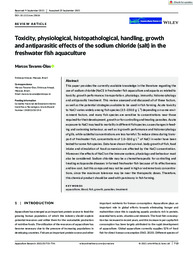Toxicity, physiological, histopathological, handling, growth and antiparasitic effects of the sodium chloride (salt) in the freshwater fish aquaculture.
Toxicity, physiological, histopathological, handling, growth and antiparasitic effects of the sodium chloride (salt) in the freshwater fish aquaculture.
Autoria: TAVARES-DIAS, M.
Resumo: This paper provides the currently available knowledge in the literature regarding the use of sodium chloride (NaCl) in freshwater fish aquaculture and aquaria as related to toxicity, growth performance, transportation, physiology, immunity, histomorphology and antiparasitic treatment. This review assessed and discussed all of these factors, as well as the potential strategies available to be used in fish farming. Acute toxicity to NaCl varies widely among fish species (3.5?150.0 g L?1) depending on some environment factors, and many fish species are sensitive to concentrations near those required for their development, growth or for controlling and treating parasites. Acute exposure to NaCl may lead to mortality in different fish species, cause changes in feeding and swimming behaviour, as well as in growth performance and histomorphology of gills, while sublethal concentrations are less harmful. To reduce stress during transport of freshwater fish, concentrations of 1.0?10.0 g L?1 of NaCl in water have been tested for some fish species. Data have shown that survival, body growth of fish, food intake and stimulation of food conversion are affected by the NaCl concentration. Moreover, the effects of NaCl on the immune system, physiology and behaviour must also be considered. Sodium chloride may be a chemotherapeutic for controlling and treating ectoparasite diseases in farmed freshwater fish because of its effectiveness and low cost, but this compound may not be used in high or extreme toxic concentrations, since the maximum tolerance may be near the therapeutic doses. Therefore, this chemical product should be used with parsimony in fish farming.
Ano de publicação: 2022
Tipo de publicação: Artigo de periódico
Unidade: Embrapa Amapa
Palavras-chave: Peixe de Água Doce
Observações
1 - Por padrão são exibidas publicações dos últimos 20 anos. Para encontrar publicações mais antigas, configure o filtro ano de publicação, colocando o ano a partir do qual você deseja encontrar publicações. O filtro está na coluna da esquerda na busca acima.
2 - Para ler algumas publicações da Embrapa (apenas as que estão em formato ePub), é necessário ter, no celular ou computador, um desses softwares gratuitos. Sistemas Android: Google Play Livros; IOS: iBooks; Windows e Linux: software Calibre.
Acesse outras publicações
Acesse a Base de Dados da Pesquisa Agropecuária (BDPA) para consultar o acervo completo das bibliotecas da Embrapa.

